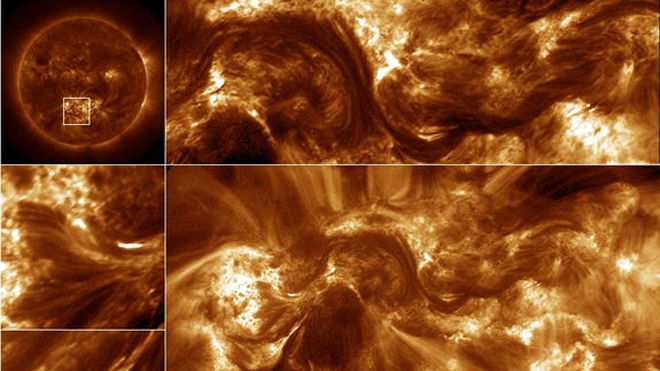 The Sun is the center of our Solar System. Scientists have long puzzled over why the surface of the sun is cooler than its corona, the outer hazy atmosphere visible during a solar eclipse. Now thanks to a five-minute observation by a ultraviolet telescope they have some magnetic answers. A rocket-borne camera has provided some of the sharpest images yet of the Sun’s corona, the hot layer of gas that extends more than a million kilometers above the solar surface.
The Sun is the center of our Solar System. Scientists have long puzzled over why the surface of the sun is cooler than its corona, the outer hazy atmosphere visible during a solar eclipse. Now thanks to a five-minute observation by a ultraviolet telescope they have some magnetic answers. A rocket-borne camera has provided some of the sharpest images yet of the Sun’s corona, the hot layer of gas that extends more than a million kilometers above the solar surface.
A corona is a type of plasma atmosphere of the Sun or other stellar celestial body, extending millions of kilometers into space, most easily seen during a total solar eclipse. The high temperature of the corona gives it unusual spectral features. These spectral features have since been traced to highly ionized iron (Fe-XIV) which indicates a plasma temperature in excess of 106 kelvin. The fact that the Sun has a million-degree corona was first discovered by Gotrian in 1939 and Bengt Edlén in 1941 by identifying the coronal lines (observed since 1869) as transitions from low-lying metastable levels of the ground configuration of highly ionized metals.
“It’s counter-intuitive for us here on Earth because as you go up in altitude, the temperature decreases,” says Jonathan Cirtain, an astrophysicist at NASA’s Marshall Space Flight Center in Huntsville, Alabama.
For decades, researchers have suspected that powerful magnetic fields are heating the corona. “The Sun’s atmosphere is just jam-packed full of magnetic field,” says Cirtain. As the lines of those fields cross and twirl, the theory went, they push and pull the charged gas in the corona, giving it the energy that heats it up.
The problem is that nobody has been able to see the magnetic fields in close-up until now. Cirtain and his team have developed the High-resolution Coronal Imager (Hi-C), a camera capable of taking pictures of the Sun’s corona in fine detail. The imager was placed on board a research rocket at the White Sands Missile Range in New Mexico and flown to the edge of space. It took several minutes to fall to Earth, during which time it took a series of pictures of the Sun.
“Magnetic braiding” is believed to happen when small bundles of magnetic fields become wrapped around each other due to plasma moving around on the sun’s surface.
Follow-up observations are needed to learn if the magnetic braiding phenomenon is widespread and how important is it to coronal heating.
“Are twisted-up field lines just all over the place? Do they only happen near inversion layers, where you go from a positive net flux out from the sun’s surface to negative net flux into the surface? How prevalent is this structure to the overall sun and how important is it to heating the sun’s atmosphere? I think that’s the next step that we will take,” Cirtain said.
Author : Andy Soos




































